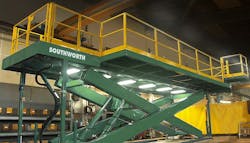Assembling any complex product can often become an especially labor-intensive—not to mention callisthenic—activity.
Whether that product is something as relatively small as a skid steer or as massive as an aircraft wing, the assembly job will often require any single worker to crawl on hands and knees, fetch and climb ladders, and continuously reach far past ergonomic guidelines to access each part of the build. As they do this, they must also regularly stop work to retrieve materials and instructions for the job.
By some estimates, all this repositioning, fetching, and stretching can account for as much as 20% of the total labor time.
In the past, this was just part of the job. Exhaustion and rotator-cuff injuries aside, it was deemed an “efficient enough” process. Though work access lifts have been available for decades, they were rarely used for small or mid-sized assembly jobs where ladders or scaffolding would otherwise suffice.
Over the last few years, however, this has begun to change.
Work access lifts, once viewed as necessary only for massive assembly operations, have now become a critical tool for unlocking profound productivity and quality improvements for assembly jobs of any size.
As Jim Galante—director of business development at Southworth Products Corp—sees it, this uptick in usage is being driven by a number of macro trends that affect the entire manufacturing industry. It begins with the age-old issue of the skills gap.
“We just don't have a lot of young people coming into this business,” he says. “That means the people on the line doing the work on big assemblies tend to be older.”
And by no small measure. By Galante's calculations, the average worker in this industry has aged from around 27 to about 48 years old today.
While this does mean there is more experience and expertise on the line, it also means that "we've got a workforce that is not quite as agile and not quite as quick to run up and down a ladder or crawl on a scaffold as they used to be," Galante says.
This fact rubs against another challenging change in the industry: demand for productivity.
"We have domestic productivity pressure and we have foreign pressure and we have management trying to do more with less," Galante says. Added together, this means there is a strong desire to make work faster, safer and easier than ever before.
The answer to that, the industry trends suggest, is wider use of work access lifts.
From Ergonomic Tool to Productivity Powerhouse
Since they hit the market, the key selling point for work access lifts has been their clear ergonomic benefits. Basically, if the worker isn't kneeling, climbing, or reaching to access his or her job, the risk of injury or fatigue is diminished. But it means much more than that today.
"Even though we say that work access lifts are very good ergonomic tools because they position the worker to the work—which is the foundation of ergonomics—the real gain for the company is productivity and efficiency," Galante says. "It's a no-brainer—if you want to improve output, let's position the worker ideally so he can get the work done efficiently."
Taking advantage of these tools and this "no-brainer" approach to productivity no longer requires massive assembly jobs, he adds.
He points to one recent project in particular to demonstrate the point—a customer has large cylindrical objects 4 to 8’ tall suspended from the overhead conveyor (figure 1). These cylinders receive a special coating that has to be thoroughly inspected and any voids or imperfections repaired before moving them into the baking oven. The large size of the objects combined with the fact they are suspended above the floor made the inspection a big problem. Now work access lifts position inspectors at just the right height to view the entire surface area, anywhere from top to bottom.
"The ideal position for this job is to put the work from 30 to 40 inches above the floor, so we're only raising or lowering the worker maybe two or three feet," Galante says. "But by positioning the worker to the ideal ergonomic position, he tends to be much more efficient—he can stand erect, he's biomechanically as strong as he's ever going to be, and he's less likely to fatigue."
"And," he notes, "when you consider that these workers are 55, not 25, that's a really important factor."
Adding to this evolution of lift use, Galante says, is also an overall evolution of lift functionality.
"More and more often, these work access lifts are not just raising the worker on a 2 x 3-foot platform like we see at construction sites, but large, six, eight, 10-foot-wide platforms that are 20 feet long," he explains. "With these, we're not only raising the worker, we're raising the tools—we're raising his workbench with his computer and documentation, we're raising the materials that he uses, even building conveyors to convey all the materials he needs to do his job right up on the work platform. It’s also not uncommon to see a lift that is L-shaped or U-shaped so a worker can access multiple sides of an assembly.”
Customization to the job is what allows a work access lift to really improve worker productivity. “We’re seeing all kinds of customization that allows these lifts to be extremely versatile. Think of the side of airplane fuselage that is curved,” says Galante. “A standard lift platform that provides access to the middle or widest point of the fuselage would be of little help when the worker needed access to higher or lower sections. But put a retractable slide-out platform on the lift and the worker can get up good and close whether they are working at the bottom, middle or top of the structure.”
In other words, modern solutions not only solve the crawling-climbing-reaching issue, but they also resolve every productivity-killing part of an assembly process.
The result of this can be a massive boost to productivity.
"We know, if there's not good ergonomics, there is going to be a productivity bottleneck," Galante says. "So, if we can put all the materials and components at one level and raise or lower a worker with all those materials and tools, we’re eliminating a lot of wasted motion, a core LEAN value, and we’re going to get back some really good productivity gains."
In this case, the results can be impressive. "We can improve productivity by 10, 20, 30%," Galante says. "And that makes for a pretty quick ROI."
For more information, please visit www.SouthworthProducts.com
About the Author
Travis Hessman
VP of Content, Endeavor Business Media
Travis Hessman is the VP of Content for Endeavor Business Media. Previously, Travis was the Editor-in-Chief for Industry Week and New Equipment Digest as well as the Group Editorial Director for Endeavor's Manufacturing Group.
He began his career as an intern at IndustryWeek in 2001 and later served as IW's technology and innovation editor. Today, he combines his experience as an educator, a writer, and a journalist to help address some of the most significant challenges in the manufacturing industry, with a particular focus on leadership, training, and the technologies of smart manufacturing.






